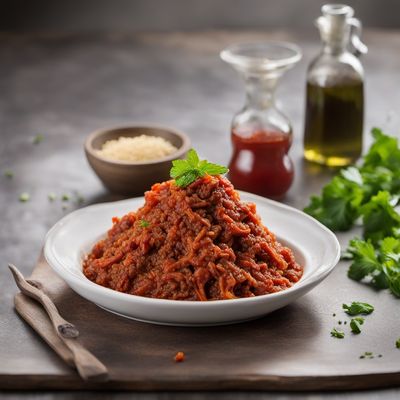
Ingredient
Sesame paste (tahini) (sesamus indicum)
The Creamy Delight: Unveiling the Magic of Sesame Paste
Sesame paste, also referred to as tahini, is a smooth and creamy paste made from ground sesame seeds. It has a light beige color and a velvety texture. The flavor of tahini is distinctively nutty, with a hint of bitterness. Its consistency is similar to that of peanut butter, making it easy to spread or incorporate into various recipes. Tahini is a key ingredient in Middle Eastern and Mediterranean cuisines, where it is used in dishes like hummus, baba ganoush, and halva. It is also gaining popularity in global cuisine for its versatility and unique taste.
Origins and history
Sesame seeds, the main ingredient in tahini, have a rich history dating back thousands of years. They are believed to have originated in Africa and were cultivated in ancient civilizations such as Egypt and Mesopotamia. Sesame seeds were highly valued for their oil content and were used for medicinal and culinary purposes. Tahini, as we know it today, has its roots in the Middle East, where it has been a staple ingredient for centuries. It has since spread to various parts of the world, becoming a beloved ingredient in many cuisines.
Nutritional information
Tahini is a nutrient-dense ingredient, packed with essential minerals such as calcium, iron, and magnesium. It is also a good source of healthy fats and plant-based protein. A 2-tablespoon serving of tahini provides approximately 180 calories.
Allergens
Sesame paste (tahini) may be an allergen for individuals with sesame seed allergies.
How to select
When selecting tahini, look for a brand that uses high-quality sesame seeds and has a smooth and creamy consistency. Avoid products with added oils or preservatives. Opt for organic or natural tahini whenever possible for a purer flavor.
Storage recommendations
Store tahini in a cool, dry place, preferably in an airtight container. It can be refrigerated to extend its shelf life and prevent the oil from separating. Before using refrigerated tahini, let it come to room temperature and stir well to recombine the oils.
How to produce
To produce tahini at home, toast sesame seeds until golden brown, then grind them in a food processor until a smooth paste is formed. Add a small amount of oil, such as olive oil, to achieve the desired consistency.
Preparation tips
Tahini can be used as a base for dressings, sauces, and dips. It can also be incorporated into baked goods, smoothies, and desserts. When using tahini, stir it well before measuring, as the oil tends to separate. To enhance its flavor, consider adding a squeeze of lemon juice or a pinch of salt. For a creamier consistency, mix tahini with water or olive oil until desired thickness is achieved.
Culinary uses
Tahini is a versatile ingredient used in a variety of dishes. It is a key component in traditional Middle Eastern recipes such as hummus, falafel, and tahini sauce. It can also be used as a spread on sandwiches or as a dressing for salads. In baking, tahini adds a unique flavor to cookies, cakes, and bread. Its creamy texture makes it an excellent base for vegan sauces and dressings.
Availability
Sesame paste (tahini) is commonly available in Middle Eastern markets, health food stores, and well-stocked supermarkets worldwide.
More ingredients from this category
Recipes using Sesame paste (tahini) (sesamus indicum) » Browse all

Moroccan-inspired Gumbo
Spicy and Flavorful Moroccan Gumbo: A Fusion of American and Moroccan Cuisine

Homemade Spicy Tantanmen Ramen
Fiery Delight: Homemade Spicy Tantanmen Ramen

Moroccan-inspired Ramen
Spiced Lamb Ramen with Harissa Broth

Halawet Ahmad - Asian Fusion Delight
Coconut Rice Rolls with Sweet Sesame Filling - A Fusion of Flavors

Tunisian-inspired Spiced Cabbage Stew
Harissa-infused Cabbage Delight

Tunisian-inspired Stuffed Pasta with Spiced Meat Sauce
Harissa-infused Tordelli: A Tunisian Twist on Italian Stuffed Pasta

Moroccan-style Pho
Spiced Beef Noodle Soup with Moroccan Flavors

Moroccan-style Huevos Rancheros
Spiced Eggs with Moroccan Flavors

Arab-inspired Bangers and Mash
Sausages and Mashed Potatoes with a Middle Eastern Twist

Bukharan Jewish-style Eggplant Salad
Savory Delight: Bukharan Jewish Eggplant Salad

Hummus Kawarma with a Twist
Elevated Hummus Delight: A Haute Cuisine Twist on a Lebanese Classic

Northeastern Chinese Style Mille-feuille
Crispy Layers of Delight: Northeastern Chinese Mille-feuille
